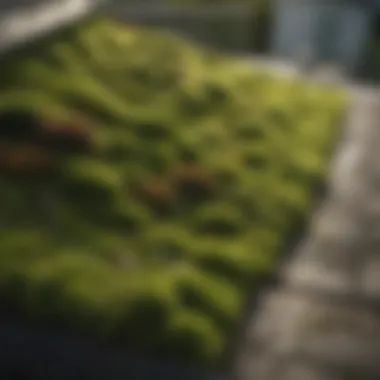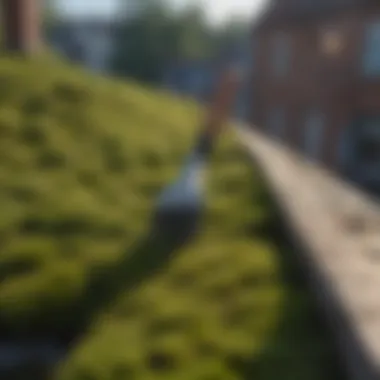Moss on Roof Removal: Essential Guide for Homeowners


Intro
Moss growth on roofs is a common issue for many homeowners. It’s not just an aesthetic problem; it can lead to significant damage to roofing materials if left unattended. This guide will explore effective methods for removal, discuss contributing factors to moss growth, and examine how to maintain your roof to prevent future infestations. Understanding the nature of moss and its impact on your home is essential for any homeowner,
making it a priority to address before it escalates.
Factors Influencing Moss Growth
Moss thrives in damp, shaded environments. Several factors contribute to its growth:
- Shade: Overhanging trees cast shadows on roofs, creating a perfect habitat for moss.
- Moisture: Accumulation of water from rain or condensation can lead to moss formation.
- Roof Material: Certain materials, like wood, are more susceptible to moss than others.
Addressing these conditions is the first step in moss prevention.
Effective Removal Techniques
Various techniques can effectively remove moss from your roof:
- Manual Removal: Using a stiff-bristle brush, gently scrub the moss off your roof. Be careful to avoid damaging shingles.
- Chemical Solutions: There are several commercial moss removers available, like Wet & Forget or moss killer sprays, which you can apply according to the manufacturer’s instructions.
- Pressure Washing: High-pressure washing may be effective but can also damage your roof, particularly older shingles.
Always prioritize safety when cleaning your roof. Use a harness and make sure to use ladders correctly.
"Preventing moss growth not only extends the lifespan of your roofing materials, but also improves your home’s curb appeal." - Roof Maintenance Specialist
Maintenance and Upkeep
Maintaining your roof requires regular attention. Consider these aspects for long-term care:
- Seasonal Inspections: Check your roof each season for signs of moss or other damage, especially after heavy storms.
- Gutter Cleaning: Clean your gutters to ensure water flows off your roof efficiently and does not pool, which could encourage moss growth.
- Trim Overhanging Branches: Regularly maintain trees around your home to minimize shade on your roof.
Epilogue
Investing time in roof maintenance is not just about aesthetics; it's about preserving the integrity of your home. Regular inspections, combined with effective moss removal techniques and preventative measures, ensure a long-lasting roof free from moss. This guide serves as a foundational resource for homeowners looking to understand moss removal comprehensively.
Understanding Moss on Roofs
Moss growth on roofs is not just an aesthetic issue; it can lead to significant structural problems if left unchecked. Understanding the nature of moss, how it thrives, and the conditions that encourage its growth is crucial for homeowners. This knowledge empowers property owners to make informed decisions regarding maintenance and removal.
A primary reason to understand moss is its potential to cause damage to roofing materials. Roofs are designed to protect homes from the elements. However, moss can trap moisture, leading to rot and other forms of deterioration in shingles and tiles. Moreover, certain types of moss can exacerbate leaks, making homes vulnerable to water damage. Therefore, recognizing the presence and implications of moss is vital for preserving the integrity of your roof.
Additionally, the biological makeup of moss and its life cycle needs attention. Unlike common plants, moss does not have roots. It absorbs water directly from its surroundings, making it well-adapted to damp environments. Therefore, understanding its preferences can aid in proactive prevention measures.
A key benefit of recognizing how moss affects roofs is the prevention of costly repairs and extensive maintenance later on. Identifying moss growth early allows homeowners to act before significant damage occurs. Furthermore, knowing the reasons why moss thrives will enable homeowners to adjust their landscape and roof maintenance routines appropriately.
"An ounce of prevention is worth a pound of cure." This saying holds true for moss management as well. Knowing what moss is and how it behaves can ultimately save homeowners time, effort, and money in the long run.
Understanding moss on roofs creates an opportunity for preventative practices. In this article, we will explore various aspects, including what moss is, how it flourishes on roofs, and the environmental influences that facilitate its growth. This comprehensive approach ensures that readers acquire all the relevant information needed to manage moss effectively.
Identification of Moss Problems
Understanding the identification of moss problems is critical for homeowners. Early detection of moss on roofs can significantly mitigate damage and reduce removal costs. Moss can easily accumulate over time, often going unnoticed until considerable harm has occurred. This section will focus on recognizing signs of infestation and understanding the potential damage that maltreatment can inflict on roofing materials.
Signs of Moss Infestation
Identifying moss on your roof starts with a keen observation of certain signs that may indicate an infestation. Homeowners should regularly inspect their roofs, especially following rainy periods or high humidity, as these conditions tend to favor moss growth.


Some indicators of moss presence include:
- Visual Evidence: Moss appears as green patches on the roof surface. It often thrives in shaded areas where sunlight is scarce. Inspecting these regions is vital.
- Texture Changes: The texture of the roof may feel softer or spongier where moss has grown, indicating a possible root system lodging itself between shingles.
- Water Drainage Issues: Moss can obstruct water drainage, leading to pooling. Look for standing water around these areas, which may suggest a moss problem.
- Growth Patterns: Moss spreads slowly but can multiply rapidly under favorable conditions. Notice if the patches are increasing in number or size over time.
Keeping an eye on these signs allows for timely intervention, preventing further complications.
Potential Damage to Roofing Materials
Moss does not just serve as an aesthetic problem; it can seriously damage roofing materials. Understanding the potential damage aids in grasping why prompt action is needed.
- Moisture Retention: Moss absorbs moisture. When this water infiltrates underneath roofing shingles, it leads to wood rot and deterioration, weakening the overall integrity of the roof structure.
- Shingle Damage: The roots of moss can lift shingles, creating gaps and allowing more water to infiltrate. This can result in leaks inside the home, leading to expensive repairs over time.
- Increased Energy Costs: A damaged roof can lead to issues with insulation. Consequently, homeowners might incur higher heating and cooling costs due to compromised energy efficiency.
- Aesthetic Decline: While not a structural concern, moss can negatively impact the visual appeal of a property. Buyers often look unfavorably upon homes with evident moss issues.
In summary, recognizing signs of infestation, understanding the potential damage, and taking action to solve these issues are essential for maintaining a healthy roof and a secure home.
Moss Removal Techniques
Moss removal is a critical aspect of roof maintenance. Ignoring it can lead to significant damage over time. Understanding the various methods available for removing moss can help homeowners make informed decisions. Each technique has its own set of advantages and considerations. Therefore, exploring these methods in depth is essential to ensure long-lasting protection for roofs.
Manual Removal Methods
Manual removal of moss is often considered the safest approach, especially for small infestations. This method involves using hands or simple tools like brushes or scrapers to physically detach the moss from the roof surface.
Benefits of manual removal include:
- Targeted Application: Homeowners can focus only on the affected areas without affecting surrounding structures.
- Minimal Chemical Use: Reducing reliance on chemicals can have positive environmental impacts.
However, this method requires physical effort and can be time-consuming. It is crucial to ensure safety while on the roof, using proper ladders and harnesses as needed. Additionally, care must be taken to avoid damaging shingles or underlying roofing materials during the process.
Chemical Solutions: Effectiveness and Safety
Chemical solutions are popular for more extensive moss problems. Products like sodium hydroxide, potassium salts, and specifically formulated moss removers effectively kill moss and limit regrowth. These products are often easy to use, requiring simple application and waiting periods to see results.
While they can be effective, safety is a paramount concern. Homeowners must:
- Read Labels Carefully: Understand the exact contents and follow instructions.
- Protect Surrounding Plants: Some chemicals can harm nearby vegetation, so cover plants or choose targeted applications.
It's also worthwhile to note that these solutions might not be necessary for minor infestations. Weighing the severity of the problem against the potential risks of using harsh chemicals is wise before proceeding.
Power Washing: Pros and Cons
Power washing is another common method for removing moss. This technique uses high-pressure water to wash away moss from roofs. It can be fast and efficient, making it appealing for larger surfaces.
However, power washing comes with pros and cons. On the positive side:
- Speed: It enables quick removal of moss and other debris.
- Effectiveness: High pressure can dislodge even hardened growth.
On the downside, power washing can be:
- Destructive: If not done carefully, it can strip roofing materials or contribute to water damage.
- Not Suitable for All Roofs: Some roofs cannot withstand the pressure, leading to problems.
Ultimately, power washing should be conducted by professionals or those experienced with handling such equipment to mitigate risks associated with this method.
"No single method is universally perfect; each has its strengths and weaknesses depending on specific circumstances."
Whether opting for manual removal, chemicals, or power washing, understanding the characteristics of each technique is essential in executing safe and effective moss removal.


Assessing Local Moss Removal Services
Assessing local moss removal services is an essential step in maintaining the integrity of your roof. Homeowners may experience a myriad of issues when dealing with moss. An infestation not only affects the aesthetic appeal of a property but can also lead to significant damage over time. Due to this, it is critical to find reliable and effective removal experts in your area.
When you approach this task, it becomes important to consider factors such as the expertise of service providers, their methods of operation, and their overall reputation. Choosing the right service can ensure that moss is addressed timely and effectively, preventing future regrowth and protecting your investment in your home. This section aims to guide you through finding qualified professionals near you and how to evaluate their services to make an informed decision.
Finding Moss Removal Experts Near You
Start your search for moss removal experts by gathering recommendations from various sources. Consider asking friends, neighbors, and local home improvement stores for suggestions. Online platforms can also provide valuable insights. Websites like Reddit or Facebook communities often have discussions and reviews related to local services.
In addition to personal recommendations, use search engines to look for moss removal companies in your area. Focus on businesses that specialize in this field, as they will have the necessary experience. Pay attention to platforms like Yelp or Google Reviews; customer feedback can offer a closer look at the reliability and quality of the service.
Lastly, generate a list of potential professionals and look into their websites or online profiles. Look for details about their services, years of experience, and any certifications they may have. This will help in creating a strong initial pool of candidates.
Evaluating Service Providers
After compiling a list of potential moss removal experts, assessing their qualifications is essential. Begin by checking their certifications and licenses. Proper licensure ensures they meet local regulations, which can vary by region.
Next, inquire about their methods for moss removal. Experts should provide insight into whether they use manual techniques, chemical treatments, or a combination of both. Each method has its pros and cons, so understanding their approach can help in assessing their suitability for your needs.
Here are some considerations to keep in mind during the evaluation process:
- Experience: Ask how long they have been in the business. More experienced companies usually have a good track record dealing with various roof types and moss issues.
- Insurance: Check if they carry liability insurance. This protects both you and the service provider in case of accidents or damages.
- Cost Estimates: Obtain detailed written estimates from multiple service providers. Compare the costs, but also focus on what’s included in each quote. Cheaper doesn't always mean better.
- Warranty: Reliable service providers often offer warranties for their work. A guarantee can provide peace of mind regarding the effectiveness of the moss removal.
"Always take the time to evaluate the qualifications and experiences of moss removal providers. A small effort in assessing providers can save you significant costs down the line."
In summary, thoroughly researching and evaluating local moss removal services will contribute significantly to effective roof maintenance. Make informed choices to ensure the longevity of your roof and home.
Costs Involved in Moss Removal
Understanding the costs associated with moss removal is essential for homeowners. This section sheds light on the specific elements that contribute to the overall expenditure, which can help individuals make informed decisions. It is not only about the immediate financial outlay but also entails considering the potential impact on a home’s long-term value. Homeowners must weigh the benefits of moss removal against the costs.
Factors Influencing Cost
Several elements can influence the cost of moss removal services. Recognizing these factors can assist homewoners in both budget planning and choosing the right service provider. Here are some key considerations:
- Roof Size: Larger roofs typically require more time and resources for moss removal, leading to higher costs.
- Moss Severity: If the moss infestation is extensive, requiring additional effort and time, this will increase the pricing.
- Type of Roof Material: Different roofing materials may require specialized cleaning methods, which can also affect overall costs.
- Access Difficulty: If the roof has complicated access points, such as steep pitches or multiple levels, labor costs may rise due to the additional safety measures needed.
- Location: Local market rates also play a significant role; urban areas may have higher costs compared to rural locations.
Effectively, these factors create a varied pricing landscape for moss removal services.
Average Price Range
On average, homeowners can expect to spend between $300 and $1,500 for professional moss removal. This price range primarily depends on the factors identified earlier. For instance, smaller, uncomplicated roofs might fall closer to the lower end of this spectrum.
In contrast, extensive removals on larger or more complex roofs can quickly escalate costs. Here is a breakdown of average pricing:
- Small Roofs (up to 1,500 sq ft): Generally between $300 to $800.
- Medium Roofs (1,500 to 3,000 sq ft): Typically range from $600 to $1,200.
- Large Roofs (over 3,000 sq ft): Can cost between $1,000 and $1,500 or more.
It’s crucial for homeowners to obtain multiple quotes before deciding. This practice ensures the selection of a reputable provider at a fair price.
Safety Considerations
In the process of moss removal from roofs, safety is an essential aspect that cannot be overlooked. Engaging in this task without proper precautions can lead to accidents, injuries, or even property damage. Moss growth often creates a slippery surface, increasing the risk of falls. Understanding and implementing effective safety measures before, during, and after the removal process is critical.
Personal Safety Precautions


When tackling moss removal, taking personal safety precautions is vital. Homeowners should wear appropriate protective gear, such as:
- Gloves: Protect your hands from sharp moss pieces and chemicals.
- Safety goggles: Shield your eyes from debris that may fly up during removal.
- Non-slip footwear: Avoid falls by using shoes with gripped soles.
Moreover, ensure that you are physically fit to climb onto rooftops. If there are uncertainties regarding your ability to safely access the roof, it may be wiser to consult professionals. Using a sturdy ladder that is in good condition can prevent accidents during the moss removal process. It is advisable to have a partner assist you—someone to hold the ladder and provide support.
Using Equipment Safely
Safe equipment usage is equally crucial during moss removal. Various tools can aid in this process, but mishandling them may result in injury or damage.
When using a pressure washer, consider the following:
- Choose the right pressure: Use a lower pressure setting to avoid damaging roofing materials.
- Maintain a safe distance: Keep the nozzle at an adequate distance from the surface to minimize the risk of injury and ensure effective cleaning.
- Secure electrical cords: If using electric equipment, ensure that cords do not pose tripping hazards.
Using chemical solutions requires specific attention as well:
- Read labels carefully: Always follow the manufacturer’s instructions for application and safety.
- Ventilation: Ensure proper airflow around the area when using chemicals to prevent inhalation of harmful fumes.
- Dispose properly: After usage, dispose of chemical containers following local regulations to avoid environmental harm.
"Prioritizing safety precautions can lead to a successful moss removal experience while protecting yourself and your property."
By adhering to these safety considerations, you not only protect yourself but also enhance the effectiveness of the moss removal process.
Preventative Measures Against Moss Growth
Preventing moss growth on roofs is critical for maintaining the integrity and longevity of your roofing materials. Regular maintenance not only minimizes aesthetic issues but also protects against potential structural damage. By implementing effective preventative measures, homeowners can significantly reduce the likelihood of a moss infestation, leading to lower maintenance costs and improved overall home value.
Regular Roof Maintenance Practices
Routine roof maintenance is essential in preventing moss accumulation. This process includes several specific practices:
- Routine Inspections: Inspect your roof at least twice a year. Look for areas where moss may begin to take hold, especially in shaded spots where moisture lingers.
- Debris Removal: Remove leaves, twigs, and other debris that can trap moisture. This is especially important in valleys and gutters where water might accumulate.
- Roof Cleaning: Consider professional roof cleaning services that use safe methods to remove existing moss and prevent new growth. Avoid harsh chemicals that could damage roofing materials.
- Ensure Proper Drainage: Check that gutters and downspouts are clear. Overflowing gutters can lead to water pooling on the roof, creating a suitable environment for moss.
By adhering to these practices, homeowners can keep their roofs dry and less conducive to moss growth.
Landscape Management to Prevent Moss
In addition to roof care, landscaping choices can impact moss development. Here are some management strategies:
- Trim Overhanging Branches: Limit shade by pruning trees and shrubs. Sunlight helps dry out the roof, discouraging moss growth.
- Create Space between Vegetation and Roof: Maintain a distance between plants and the roof. This allows for better air circulation and sunlight penetration.
- Use Acidic Soils Wisely: Moss prefers moist, acidic soils. If possible, avoid planting acidic plants too close to the foundation and roof, as this can lead to increased moss risk.
Implementing these landscape strategies can significantly reduce the habitat suitable for moss, creating a proactive defense against its growth.
"Prevention is better than cure. By addressing moss growth proactively, homeowners can save time and money in the long run."
The End and Recommendations
In the management of moss on roofs, understanding the various strategies for removal and prevention is crucial. This conclusion aims to synthesize the key elements discussed throughout the article while offering recommendations for homeowners. To maintain the integrity of roofing structures, proactive approaches to moss management must be emphasized. Effective moss removal not only enhances the aesthetic appeal of homes but also protects roofing materials from potential deterioration over time.
Summary of Moss Management Strategies
The article has outlined a spectrum of effective moss management methods. Key strategies include:
- Regular Inspection: Homeowners should routinely check their roofs for the presence of moss or any signs of infestation. Early detection can significantly reduce removal costs and potential damage.
- Physical Removal: Methods such as manual scraping or the use of a roof rake can be ideal for small infestations.
- Chemical Treatments: Employing moss-killing solutions can be effective, but attention must be paid to the safety and environmental impact of these products.
- Preventative Measures: Keeping the roof clean and well-maintained, addressing landscape factors, and ensuring proper sunlight exposure can inhibit moss growth effectively.
Implementing these strategies as part of an ongoing roof maintenance plan can ensure longevity and prevent significant repair costs down the line.
When to Seek Professional Help
While many homeowners can manage minor moss issues, some situations necessitate professional intervention. Consider contacting an expert if:
- Severe Infestation: If moss has extensively spread and is affecting large areas, professional services might be required for effective removal.
- Safety Concerns: For roofs that are steep or high, approaching it without expertise can be dangerous. In these cases, it is safer to engage qualified professionals.
- Limited Time or Resources: Homeowners with busy schedules may not have the time or tools needed for efficient removal and should consider hiring a specialist.
- Complex Roofing Materials: If your roof is made of delicate materials, such as slate or wood, professional knowledge will help avoid further damage during the removal process.
In summary, a cohesive approach to moss management—encompassing routine checks, removal, and preventative actions—is essential for maintaining a healthy roof. Seeking professional help when needed ensures safety and optima results.







